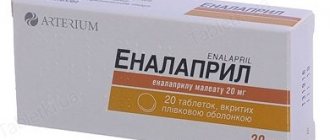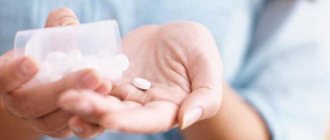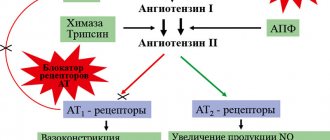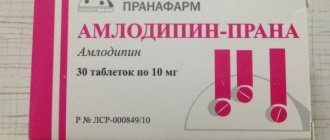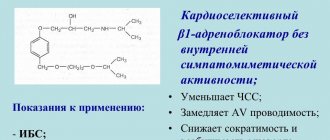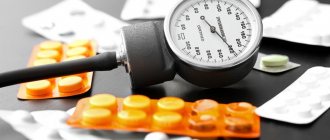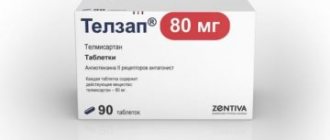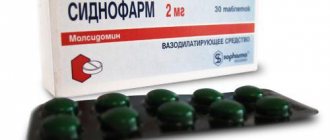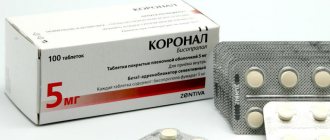Pathologies of the heart and blood vessels, and primarily essential hypertension, have now reached epidemic proportions. The choice of medications for their treatment is huge, but disability and mortality from these diseases continue to increase.
Complex therapy necessarily includes drugs with a strong evidence base, such as ACE inhibitors, regulated by the international medical community. Regardless of the characteristics of the course of diseases of the cardiovascular system, they are an obligatory component of a combined treatment regimen. In the half century since the introduction of the pilot drug, ACE inhibitors have been constantly improved. The appearance on the pharmaceutical market of the German drug Enalapril Hexal from the company SANDOZ is called a breakthrough in cardiology.
Of all the drugs in its class, Enalapril Hexal has gained the greatest popularity, because it is a drug with a solid list of randomized trials. In clinical settings, it has been confirmed that regular use of the medication for six months reduces the risk of mortality by 40%. The lasting results of treatment have also been proven: Enalapril Hexal is one of the five ACE inhibitors recommended by the European Association of Cardiologists.
Dosage form, storage conditions and approximate cost
Enalapril Hexal can only be bought in tablet form, packaged in blisters of 5, 10, 20 mg. The package will contain 2 such plates of 10 pieces each. Multivariate dosage allows the specialist to optimally select the dose and make it easier for the patient to take the medicine. You can also identify your type by color: with a minimum dose, the tablets are white, with a medium dose they are reddish-brown, and with a maximum dose they are orange. In addition to color, each type also has the inscription “EN” with stamped dosage numbers.
For Enalapril Hexal, the price in Moscow depends on the dose, approximately 94-400 rubles. Subject to standard storage conditions (temperature - 15-25 degrees, protected from dampness, direct sunlight and children's attention), the manufacturer guarantees the suitability of the medicine for 3 years. After the expiration date, the product must be disposed of, as its effectiveness decreases and the number of unwanted reactions increases.
Release form, composition and packaging
The tablets are white, oblong, biconvex, with a smooth surface, with a notch on one side and the inscription “EN 5”, on the opposite side there is a notch at an angle of 140° (“Snap-tab”).
| 1 tab. | |
| enalapril maleate | 5 mg |
Excipients: sodium bicarbonate, lactose monohydrate, corn starch, talc, hyprolose, magnesium stearate.
10 pieces. - blisters (2) - cardboard packs.
Tablets are red-brown in color with darker or lighter inclusions, oblong, biconvex, with a smooth surface, with a notch on one side and the inscription “EN 10”, on the opposite side there is a notch at an angle of 140° (“Snap-tab”).
| 1 tab. | |
| enalapril maleate | 10 mg |
Excipients: sodium bicarbonate, lactose monohydrate, corn starch, talc, magnesium stearate, red iron oxide.
10 pieces. - blisters (2) - cardboard packs.
The tablets are light orange in color with lighter or darker inclusions, oblong, biconvex, with a smooth surface, with a notch on one side and the inscription “EN 20”, on the opposite side there is a notch at an angle of 140° (“Snap-tab”).
| 1 tab. | |
| enalapril maleate | 20 mg |
Excipients: sodium bicarbonate, lactose monohydrate, corn starch, talc, magnesium stearate, red iron oxide, yellow iron oxide.
10 pieces. - blisters (2) - cardboard packs.
Composition and mechanism of action
The basic ingredient of the medicine is enalapril maleate. The marking on the tablet indicates the amount of this component. Lactose monohydrate, talc, corn starch, and sodium bicarbonate are used as fillers and preservatives.
ACE inhibitors, which include today's medication, inhibit the activity of angiotensin-converting enzyme, the main component of the renin-angiotensin-aldosterone system. As a result of such blocking:
- Vascular tone decreases (both general and peripheral systems);
- The functionality of the endothelium improves;
- It has a positive effect on the hematopoietic system;
- Kidney performance improves, and as a result, diabetic nephropathy is prevented.
The peak activity of the tablet in the body is recorded after 6-8 hours. The result lasts for 24 hours.
Pharmacological properties of the drug
An antihypertensive drug not only relieves the symptoms of high blood pressure, but also actively influences the outcome of treatment of heart attack, ventricular hypertrophy, and CHF. Complications from target organs are also prevented, and if they are present, the opposite effect is observed.
An important advantage of Enalapril Hexal is its metabolic neutrality: the drug does not affect metabolic processes (lipid profile, glycemic level). The medicine is considered one of the safest to use (subject to the recommendations prescribed by the doctor and the instructions). It is used to prevent atherosclerotic changes and diabetic nephropathy. If you undergo a course of treatment with the drug, you can expect:
- To reduce the degree of ventricular hypertrophy;
- Normalization of indicators of its contractility;
- Improved vasodilization;
- Reduced microalbuminuria/proteinuria;
- Secondary cardioprotection;
- Improving blood supply to the kidneys and heart;
- Renoprotection;
- Reduced atherogenesis;
- Increased NO release.
In the gastrointestinal tract, as a result of complex transformations, Enalapril Hexal is converted into its active metabolite enalaprilat. Its task is to block the process of transformation of the hormone angiotensin 1 into angiotensin 2. The latter has the ability to constrict blood vessels, causing an increase in blood pressure. A decrease in angiotensin 2 levels increases renin activity and reduces aldosterone production. The vessels dilate, the load on the myocardium and oxygen deficiency are reduced. Physical endurance also increases.
Taking the drug on a regular basis prevents serious cardiovascular risks. The drug has a moderate and diuretic effect that protects the kidneys from wear and tear due to hypertension.
If the dosage is chosen accurately, there will be no disturbances in cerebral blood flow, and the pressure will generally decrease. Abruptly stopping the drug will not cause withdrawal symptoms. The drug does not worsen metabolic processes; blood glucose and uric acid remain at the same level.
General information
Among all ACE inhibitors, Enalapril Hexal is most widely used in clinical practice. This is the drug with the most randomized studies.
It has been proven that when used for 6 months, there is a reduction in the relative risk of death and reaches 40%.
The persistent effect of therapy was also confirmed. This drug is one of the five ACE inhibitors recommended by the European Association of Cardiology.
Forms and indicative prices
The drug is available only in tablet form, 5, 10, 20 mg in foil blister packs of 10 pieces. There are 2 blisters in a pack. The presence of several dosages gives the doctor ample opportunity to choose exactly the one that will suit the patient and will not bother him with dividing the tablet. They also differ in color. Tablets of 5 mg are white, 10 mg are red-brown, 20 mg are orange.
Each one has the inscription “EN”, followed by the dosage. The inscriptions and the difference in color are very convenient, because if you have different dosages of Enalapril Hexal in the house that are not stored in the package, it is very easy to figure out which tablet is which. The price of the medicine varies depending on the dosage from 94 to 400 rubles.
Composition and mechanism of action
The active component is enalapril maleate, the amount of which directly depends on the dosage. The composition also contains auxiliary components responsible for the safety of the product: lactose monohydrate, talc, corn starch, sodium bicarbonate.
It refers to drugs that block the activity of angiotensin-converting enzyme (ACE), which is the main effector of the renin-angiotensin-aldosterone system.
The consequences of this are:
- decrease in general peripheral vascular tone;
- improving the functional ability of the endothelium;
- influence on the blood coagulation system;
- improving kidney function, which entails preventing the development or progression of diabetic nephropathy.
The maximum effect of enalapril maleate occurs after 6-7 hours. The effect lasts for 24 hours.
Properties
This is a modern antihypertensive drug that not only provides an effective reduction in blood pressure, but also has a positive effect on endpoints or intermediate points (myocardial infarction, left ventricular hypertrophy, chronic heart failure, cardiovascular failure). It also prevents damage to target organs, and if they already exist, it promotes their reverse development.
One of the main qualities of Enalapril Hexal is metabolic neutrality (the drug does not affect the metabolism of glucose and fatty acids).
The drug is safe to use. Prevents the possibility of progression of atherosclerosis and diabetic nephropathy. Well tolerated by patients. With regular use, lasting positive effects are ensured:
- reduction of left ventricular hypertrophy;
- increased contractility of the left ventricle;
- improvement of coronary and renal blood flow;
- secondary cardioprotection;
- improvement of afferent and efferent vasodilation;
- reduction in microalbuminuria/proteinuria (in patients with initial microalbuminuria, the decrease in urinary albumin excretion is 49.7%);
- renoprotection;
- reducing atherogenesis;
- increased NO release.
Pharmacological properties
It is important that the tablets are quickly absorbed by the gastric mucosa, and therefore can be taken at any time, regardless of meals. . How is it different from Enalapril?
How is it different from Enalapril?
Today there is a very large selection of ACE group tablets on the market and patients are often faced with choosing which one is best. The most popular are Enalapril and Enalapril Hexal. Both medications effectively lower blood pressure and improve the functioning of the heart muscle. The main active ingredient in both drugs is enalapril maleate. This is, perhaps, all that is common between them.
Let's look at how Enalapril Hexal differs from Enalapril:
- Appearance of tablets. The manufacturer Enalapril Hexala took care of its “forgetful” patients. The appearance of tablets of different dosages differs in color, and the dosage is stamped on each.
- Enalapril Hexal lowers blood pressure more effectively and stably, and the therapeutic effect is persistent.
- Place of production: Enalapril Hexal is produced in Germany, while Enalapril is a domestically produced medicine.
Pharmacokinetics
It is important that the tablets are easy to use: since the medication is absorbed quickly, you can take it regardless of food. The active component and its metabolites come into contact with blood proteins by 50-60%. The half-life T1/2 is within 11 hours. Elimination of drug residues is carried out by the kidneys (60%) and intestines (the rest).
With renal dysfunction, drug withdrawal slows down. To avoid intoxication, the dosage is reduced. Similar recommendations apply to older patients (over 65 years old).
Enalapril and Enalapril Hexal: what is the difference
There are many medications in the ACE inhibitor class, but this does not simplify the task of choosing. Two similar drugs are often compared - Enalapril and Enalapril Hexal. Both drugs have antihypertensive properties and normalize heart rhythm. This is where their similarities end. What's the difference?
- In appearance - the manufacturer of Enalapril Hexal takes into account the forgetfulness of some patients, so its tablets are marked and vary in color (depending on the dose).
- The effect of Enalapril Hexal is more powerful, the achieved result lasts longer.
- The manufacturer of Enalapril Hexala is the German pharmaceutical company SANDOZ. Enalapril is produced in Russia.
Hexal tablets
When an allergic reaction develops, doctors prescribe antihistamines, which help relieve negative symptoms. In mild cases, you can get by with topical remedies - creams, ointments, drops for the nose, eyes, etc.
In severe cases, when clinical symptoms are most pronounced, Cetirizine Hexal tablets, which have antiallergic properties, are prescribed.
Let's look at the features of the drug and the rules of use for children and adults.
Pharmacological action and release form
What is Hexal for, patients ask? The annotation states that the tablets have an antiallergic effect. Each tablet contains 10 mg of active ingredient. You can also buy the drug in pharmacies in the form of drops, sold in bottles of 10 and 20 ml.
Worth knowing: Hexal is a blocker of H1-histamine receptors, acts as a histamine antagonist, helps eliminate allergic manifestations, and has antipruritic and antiexudative properties.
Cetirizine Hexal helps reduce the permeability of capillary walls, almost instantly relieves spasms of smooth muscles and skin reactions (especially in the cold form of urticaria). It also provides a reduction in bronchial and pulmonary hyperactivity in patients with bronchial asthma - in response to the production of histamines.
It does not have an anticholinergic effect; the tablets have a sedative effect. The result of use is revealed after 60 minutes. The maximum concentration of the active substance, along with its biological activity, is observed after four hours, and the duration of the effect is a day. The effect of the drug lasts for 72 hours after its discontinuation.
It is of no small importance that due to regular use of the drug, tolerance to the action does not develop. The active substance cetirizine is quickly absorbed.
Instructions for use and composition
The main active ingredient in tablet form and drops for oral administration is cetirizine dihydrochloride in a dosage of 10 mg. The tablets additionally contain silicon dioxide, lactose monohydrate, magnesium stearate - they enhance the effects of cetirizine and do not have biological activity.
One milliliter of drops contains the active component in a dosage of 10 mg + auxiliary components in the form of benzoic acid, propylene glycol, glycerol, purified water, sodium acetate.
The drug is recommended for the treatment of year-round and seasonal forms of rhinitis and conjunctivitis of an allergic nature. Helps cure chronic urticaria, dermatoses accompanied by itching sensations (treatment of dermatitis, neurodermatitis is advisable).
The instructions for use for Hexal state the following contraindications:
Recommended reading:
- Hypersensitivity to the active component or the drug as a whole;
- Children under 6 years of age (tablet form);
- Time of bearing a child, breastfeeding;
- Severe form of renal failure;
- Congenital or acquired lactose intolerance.
Important: the drug Hexal is prescribed with extreme caution to people in the elderly age group, with the parallel use of ethanol, barbiturates, and opioid analgesics.
During the therapeutic course, it is recommended to refrain from driving and work associated with increased concentration. With the simultaneous use of Hexal and Theophylline, a decrease in the clearance of cetirizine is observed.
The drug Hexal significantly enhances the effects of alcoholic beverages, so during treatment it is necessary to avoid their consumption. Also exclude taking Cetirizine Hexal three days before performing a skin allergy test.
Directions for use and doses
The tablets must be taken orally, swallowed whole, washed down with plenty of plain water. Do not chew, break or crush in any other way. The ideal time to take it is in the evening, since the tablets have a slight sedative effect.
For an adult, the dose is 10 mg per day (one tablet). Children from 12 years of age take one dose. The dosage may be increased due to the severity of the allergic reaction.
For information, the dosage for children 6-12 years old is determined by body weight. If the weight is more than 30 kg, then one tablet is prescribed once a day; body weight less than 30 kg – 5 mg per day, that is, ½ tablet.
How to use drops:
Recommended reading:
- For an adult and a child over 12 years of age, the daily dosage is 20 drops, which is equal to 10 mg of the active substance. Take in the evening just before bedtime;
- For children from 6 to 12 years old, the dose is also 20 drops;
- Children from 2 to 6 years old are given 10 drops in the evening, which equals 5 mg of the active ingredient;
- From one to two years, the recommended dosage is 5 drops twice a day.
In old age, no dosage adjustment is required. If the patient has a history of severe renal failure, then reduce the use by half. In case of liver failure, the dose is selected individually.
The duration of therapy for seasonal allergic rhinitis varies from 3 to 6 weeks inclusive. If the plant does not bloom for long, and the pollen affects only for a short time, then the tablets/drops are taken for 7 days.
An overdose is accompanied by severe drowsiness in adults. Children have increased irritability, anxiety and other symptoms of the central nervous system. In childhood, urinary retention, constipation, dry mouth, tachycardia, and pathological dilation of the pupils may develop.
Treatment of overdose is gastric lavage, administration of enterosorbents. Symptomatic therapy is also provided depending on the clinical manifestations. There is no antidote.
Who is SANDOZ recommended for?
We developed a drug to control blood pressure taking into account cardiovascular dysfunction. But pills are also prescribed to prevent coronary ischemia. Usually the medication is prescribed for:
- Arterial hypertension of a secondary nature, provoked by pathologies of the kidneys, heart, blood vessels;
- Chronic heart failure (as part of complex therapy);
- Left ventricular failure (acute form) - to prevent complications.
If the patient is on hemodialysis or a salt-free diet, start the course with a minimum dose, monitoring his condition daily, especially in the first week.
The drug is not prescribed:
- During gestation and lactation (there are restrictions);
- Under the age of majority (no evidence base);
- If there is a history of hypersensitivity to the components of the formula;
- Allergy sufferers (with urticaria, Quincke's edema);
- For nephropathy (in an advanced stage);
- Patients with liver dysfunction (with hepatitis, hepatosis);
ENALAPRIL HEXAL: DOSAGE
The drug is taken orally, regardless of food intake, with a sufficient amount of liquid.
The daily dose is usually taken in the morning, but can be divided into 2 doses - morning and evening.
For arterial hypertension, the initial dose is 5 mg in the morning. If blood pressure does not normalize, then the daily dose can be increased to 10 mg. The interval between dose increases should be at least 3 weeks. The maintenance dose is usually 10 mg. The maximum daily dose is 40 mg (20 mg 2 times a day).
For chronic heart failure, the initial dose is 2.5 mg in the morning. The dose should be increased gradually, depending on the patient's condition. The maintenance dose is usually 5-10 mg. The maximum daily dose is 20 mg.
For left ventricular dysfunction, the initial dose is 2.5 mg 2 times a day, dose adjustment is possible depending on the patient's condition. The average maintenance dose is 10 mg 2 times/day.
For patients with moderate renal impairment (creatinine clearance 30-60 ml/min) and patients over 65 years of age, the initial dose is 2.5 mg in the morning. The maintenance dose is usually 5-10 mg per day. The maximum daily dose is 20 mg.
For patients with severe renal impairment (creatinine clearance less than 30 ml/min) and those on hemodialysis, the initial dose is 2.5 mg/day. Hemodialysis patients should take the drug after dialysis. The maintenance dose is usually 5 mg/day. The maximum daily dose is 10 mg.
The drug can be used as monotherapy or in combination with other antihypertensive drugs, especially diuretics. When taking diuretics simultaneously, the hypotensive effect is enhanced.
How to use the tablets
The doctor will draw up an individual treatment regimen, taking into account the characteristics of the disease and the body’s reaction. In the standard version prescribed for use in the official instructions for use, the starting dose of Enalapril Hexal is 2.5 mg. Frequency of intake – 1 ruble/day. The drug is not tied to the meal schedule. The tablet is drunk whole with water (half a glass is enough).
If the starting dose does not provide the expected result, it is possible to titrate the norm to the maximum level of 20 mg/day. This portion should be taken 2 times, with an interval of 12 hours.
If the medication is used in complex therapy, the combined use of thiazide diuretics should be excluded. With this combination there is a risk of a sharp decrease in blood pressure.
Particular attention is paid to diabetics. When titrating the dose, it is important to monitor all vital signs - there is a risk of hyperkalemia, and with parallel injections of insulin, hypoglycemia.
In case of serious kidney pathologies, the medication is not prescribed without a complete preliminary examination.
Hemodialysis is not compatible with Enalapril Hexal: first, the dialysis procedure is carried out, and then the drug is prescribed in a minimal dosage.
Use for renal impairment
For patients with moderate renal impairment (creatinine clearance 30-60 ml/min), the initial dose is 2.5 mg in the morning. The maintenance dose is usually 5-10 mg per day. The maximum daily dose is 20 mg.
For patients with severe renal impairment (creatinine clearance less than 30 ml/min) and those on hemodialysis, the initial dose is 2.5 mg/day. Hemodialysis patients should take the drug after dialysis. The maintenance dose is usually 5 mg/day. The maximum daily dose is 10 mg.
Enalapril Hexal during pregnancy and breastfeeding
The official instructions warn that ACE inhibitors are able to overcome biological barriers, therefore Elanapril Hexal is canceled for the entire period of gestation and breastfeeding. It is advisable not to use the medicine already at the stage of pregnancy planning. If conception does occur during treatment with Enalapril Hexal, it should be immediately discontinued. Such strict measures are due to teratogenic effects:
- Fetal renal failure;
- Hyperkalemia in a newborn;
- Skeletal deformities;
- Underdeveloped lungs.
If the pregnant woman did take ACE inhibitors, the newborn baby is given increased attention. The body is cleansed of intoxication by blood transfusion or perineal dialysis.
Theoretically, breastfeeding is possible when using drugs in therapeutic doses. But there is no sufficient evidence base for this category of patients. First of all, the list of restrictions includes premature infants under the age of one month.
Contraindications
- history of angioedema,
- incl.
- while taking ACE inhibitors;
- stenosis (unilateral or bilateral) of the renal arteries;
- kidney diseases;
- liver diseases;
- pregnancy;
- lactation period (breastfeeding);
- age under 18 years (efficacy and safety have not been established);
- hypersensitivity to the components of the drug;
- hypersensitivity to other ACE inhibitors.
Results of drug interactions
Before prescribing Enalapril Hexala, you must warn your doctor about all medications that you are taking in parallel, especially on an ongoing basis, since the results of their combined use are not always favorable. First on this list:
- Allopurinol - reduces the concentration of leukocytes in the blood plasma;
- Analgesics, NSAIDs - inhibit the capabilities of Enalapril Hexal;
- Diuretics, opioid receptor agonists – enhance the activity of ACE inhibitors;
- Potassium-sparing agents – increase the risk of developing hyperkalemia;
- Lithium preparations – increase the level of lithium in the bloodstream;
- Insulin – the chance of hypoglycemia increases;
- Novocainamide, cytostatics, immunosuppressants, systemic corticosteroids - reduce the number of leukocytes in the blood;
- Drugs containing theophylline - Enalapril inhibits their activity;
- Medicines containing cimetidine – prolongation of the effects of Enalapril Hexal.
The tablets are strictly incompatible with alcohol, since the drug enhances the negative effects of alcohol on the heart and blood vessels.
With prolonged use of the drug, arterial hypotension may develop.
Instructions for use and composition
The main active ingredient in tablet form and drops for oral administration is cetirizine dihydrochloride in a dosage of 10 mg. The tablets additionally contain silicon dioxide, lactose monohydrate, magnesium stearate - they enhance the effects of cetirizine and do not have biological activity.
One milliliter of drops contains the active component in a dosage of 10 mg + auxiliary components in the form of benzoic acid, propylene glycol, glycerol, purified water, sodium acetate.
The drug is recommended for the treatment of year-round and seasonal forms of rhinitis and conjunctivitis of an allergic nature. Helps cure chronic urticaria, dermatoses accompanied by itching sensations (treatment of dermatitis, neurodermatitis is advisable).
The instructions for use for Hexal state the following contraindications:
Composition and instructions for use of Sebozol shampoo
- Hypersensitivity to the active component or the drug as a whole;
- Children under 6 years of age (tablet form);
- Time of bearing a child, breastfeeding;
- Severe form of renal failure;
- Congenital or acquired lactose intolerance.
Important: the drug Hexal is prescribed with extreme caution to people in the elderly age group, with the parallel use of ethanol, barbiturates, and opioid analgesics.
During the therapeutic course, it is recommended to refrain from driving and work associated with increased concentration. With the simultaneous use of Hexal and Theophylline, a decrease in the clearance of cetirizine is observed.
The drug Hexal significantly enhances the effects of alcoholic beverages, so during treatment it is necessary to avoid their consumption. Also exclude taking Cetirizine Hexal three days before performing a skin allergy test.
Side effects
The drug leads to the development of negative phenomena. The instructions divide them into frequently occurring and rarely developing ones. The first category includes disruption of the digestive tract, in most cases manifested by prolonged diarrhea.
Often patients develop paresthesia, there is unreasonable excitement, irritability, and asthenia is detected. Some complain of skin reactions in the form of pathological rash and itching.
Side effects (rare):
- Increased heart rate and pulse;
- Quincke's edema;
- Dysuria;
- Hives;
- Problems with urination;
- Weight gain;
- Disturbance of the central nervous system;
- Sleep disorder;
- Loss of consciousness;
- Unreasonable aggression;
- Musculoskeletal disorders;
- Disorders of taste perception, etc.
If negative symptoms are observed, the drug is discontinued, then you should contact a medical specialist for correction of medication prescriptions. The doctor may reduce the dosage of the drug taken or recommend an analogue with the same therapeutic properties.
Additional instructions
The medication is prescribed with extreme caution if the patient is already taking medications for concomitant diseases. In this case, the kidneys experience increased stress, so monitoring their performance is mandatory. First of all, restrictions apply to the following conditions:
- With low circulating blood volume after the use of diuretics.
- Dialysis patients using polyacrylonitrile membranes AN 69 (possible anaphylactic reaction).
- Kidney pathologies.
Before any operation, including dental procedures, you need to warn the surgeon about taking Enalapril Hexal.
special instructions
Prescribe Enalapril Hexal with caution to patients with reduced blood volume (as a result of diuretic therapy, limited salt intake, hemodialysis, diarrhea and vomiting) due to the increased risk of a sudden and pronounced decrease in blood pressure after using even the initial dose of an ACE inhibitor. Transient arterial hypotension is not a contraindication for continuing treatment with the drug after stabilization of blood pressure. If blood pressure decreases again, the dose should be reduced or the drug discontinued.
Enalapril should not be prescribed to patients undergoing dialysis using AN 69 polyacrylonitrile membranes due to the likelihood of developing anaphylactic reactions.
Kidney function should be checked before starting the drug. Patients with impaired renal function should reduce the single dose or increase the intervals between doses of the drug
Before and during treatment, blood pressure and laboratory parameters should be monitored, especially in cases of salt and/or fluid loss, impaired renal function, severe or renal hypertension, heart failure and in patients over 65 years of age.
In the case of previous treatment with diuretics, in particular in patients with chronic heart failure, the risk of developing orthostatic hypotension increases, therefore, before starting treatment with enalapril, it is necessary to compensate for the loss of fluids and salts.
In some patients with bilateral renal artery stenosis or solitary kidney stenosis, increases in blood urea and serum creatinine were observed. The changes were reversible and the indicators returned to normal after cessation of treatment.
If angioedema of the face, extremities, lips or larynx develops, the patient should immediately stop taking the drug and consult a doctor.
A cough may appear, which stops after stopping the drug.
Sudden cessation of treatment does not lead to withdrawal syndrome (a sharp rise in blood pressure). Before studying the functions of the parathyroid glands, the drug should be discontinued.
Before surgery (including dentistry), the surgeon/anesthesiologist must be warned about the use of ACE inhibitors.
The drug should be prescribed with caution to patients with diabetes mellitus due to the risk of developing hyperkalemia.
Impact on the ability to drive vehicles and operate machinery
As a result of treatment with enalapril, individual reactions may develop that may impair the patient’s ability to actively participate in road traffic, which should also be kept in mind when servicing cars and when working with devices that require increased attention. These reactions intensify with increasing doses and with alcohol intake.
Unintended consequences
Most adverse reactions are temporary and disappear after adaptation or discontinuation of the drug. Of the most common:
- Orthostatic hypotension (dizziness with a sudden change in body position);
- Dyspeptic disorders;
- Headache, loss of coordination;
- Coughing attacks;
- Dry mouth, bitter taste;
- Hyperkalemia and hypernatremia (temporarily, while taking medications).
The above symptoms should not be tolerated. If you experience any discomfort or strange sensations after taking the medicine, you should consult a doctor. A dose adjustment or drug change may be required.
ENALAPRIL HEXAL: SIDE EFFECTS
From the cardiovascular system: at the beginning of therapy, rarely - arterial hypotension (including orthostatic), dizziness, weakness, blurred vision; very rarely - chest pain, angina pectoris, palpitations, thromboembolism of the branches of the pulmonary artery.
From the respiratory system: nonproductive dry cough, interstitial pneumonitis, bronchospasm, shortness of breath, rhinorrhea, pharyngitis.
From the digestive system: dry mouth, anorexia, dyspeptic disorders (nausea, diarrhea or constipation, vomiting, abdominal pain), intestinal obstruction, pancreatitis, impaired liver function and biliary excretion, hepatitis, jaundice.
From the central nervous system and peripheral nervous system: in rare cases - headache, dizziness, weakness, increased fatigue, drowsiness, stunned consciousness; extremely rarely (when taken in high doses) - depression, sleep disturbance, peripheral neuropathy and paresthesia, muscle cramps, nervousness, tinnitus and blurred vision. These disturbances are temporary and normalize after discontinuation of the drug.
From the urinary system: rarely - renal dysfunction, proteinuria.
Metabolism: rarely - hyperkalemia, hyponatremia, taste changes (reactions are temporary and normalize after discontinuation of the drug).
From the reproductive system: very rarely, when used in high doses - impotence.
From the hematopoietic system: a decrease in the level of hemoglobin, hematocrit and platelet count is possible.
Allergic reactions: skin rash, angioedema of the face, limbs, lips, tongue, glottis and/or larynx, dysphonia, exfoliative dermatitis, exudative erythema multiforme (including Stevens-Johnson syndrome), toxic epidermal necrolysis, pemphigus, cutaneous itching, urticaria, photosensitivity, vasculitis, myositis, arthralgia, arthritis, stomatitis.
Other: very rarely, especially in patients with impaired renal function, diffuse connective tissue diseases, or during simultaneous therapy with allopurinol, procainamide or immunosuppressants, anemia, thrombocytopenia, neuropathy, increased urea concentrations, hypercreatininemia, eosinophilia may develop; in isolated cases - increased activity of liver transaminases, agranulocytosis or pancytopenia. It is necessary to regularly monitor the values of the above laboratory parameters before and during treatment, especially in patients at risk.
Most side effects are temporary and do not require discontinuation of the drug.
What do experts and users think about the medicine?
Reviews about Enalapril Hexal are encouraging: many people like the multi-variant packaging, the affordable price, and the absence of serious undesirable consequences. However, the latter argument is only possible if you strictly follow the doctor’s instructions and the manufacturer’s recommendations.
Evdokia Mikhailovna: “In my sixties, my health began to fail more and more often; before I didn’t go to the doctors so much. Moderate hypertension was recognized. They prescribed a lot of different pills - both expensive and cheap, but they were of little use. Only when Enalapril Hexal was prescribed in the medicine cabinet, I began to feel equally cheerful both in the morning and in the evening. I don’t see any serious side effects. At first I felt a little nauseous, but after about a week it went away. The doctor said to drink constantly until the pressure improves.”
Oleg: “Reliable drug. Within 2 weeks of its use, the manifestations of left ventricular failure decreased. My feelings were confirmed during the examination. The doctor also believes that Enalapril Hexal is one of the most powerful medications in its class.”
Labartkava Z.I., cardiologist: “ACE inhibitors have made a revolutionary breakthrough in medicine and have been successfully used in cardiological practice for half a century. After the advent of new generation drugs, in particular Elanapril Hexala, I prescribe it. The advantages of the drug are that it not only relieves symptoms, like its analogues, but also provides a long-term effect, as well as the prevention of severe cardiac conditions.”
The experience of doctors and patients confirms that Elanapril Hexal is a proven drug with persistent hypotensive properties. But, despite its effectiveness, the drug is not intended for self-medication, like these adapted instructions.
Enalapril's analogs
Level 4 ATX code matches:
- Dilaprel
- Prenesa
- Enap
- Diroton
- Lipril
- Renipril
- Parnavel
- Fozinap
- Tritace
- Enam
- Zokardis
- Fosinopril
- Lisinopril
- Captopril
- Monopril
- Renitek
- Hartil
- Phosicard
- Amprilan
- Ramipril
Analogs of the drug Enalapril are Berlipril , Invoril , Renitek , Ednit , Enagexal . What else can be replaced? Medicines Enam and Enap .
Lisinopril or Enalapril - which is better?
Based on research, lisinopril lowers blood pressure more effectively and also lasts for a longer period of time. Both drugs are tolerated approximately equally.
Enap and Enalapril - what's the difference?
In fact, the drugs are no different, since they have the same active substance. However, the price of Enap is much higher than its analogue.
Enalapril and Enalapril Hexal
The drug is also produced by Hexal, which is why it has the corresponding addition in the name.

